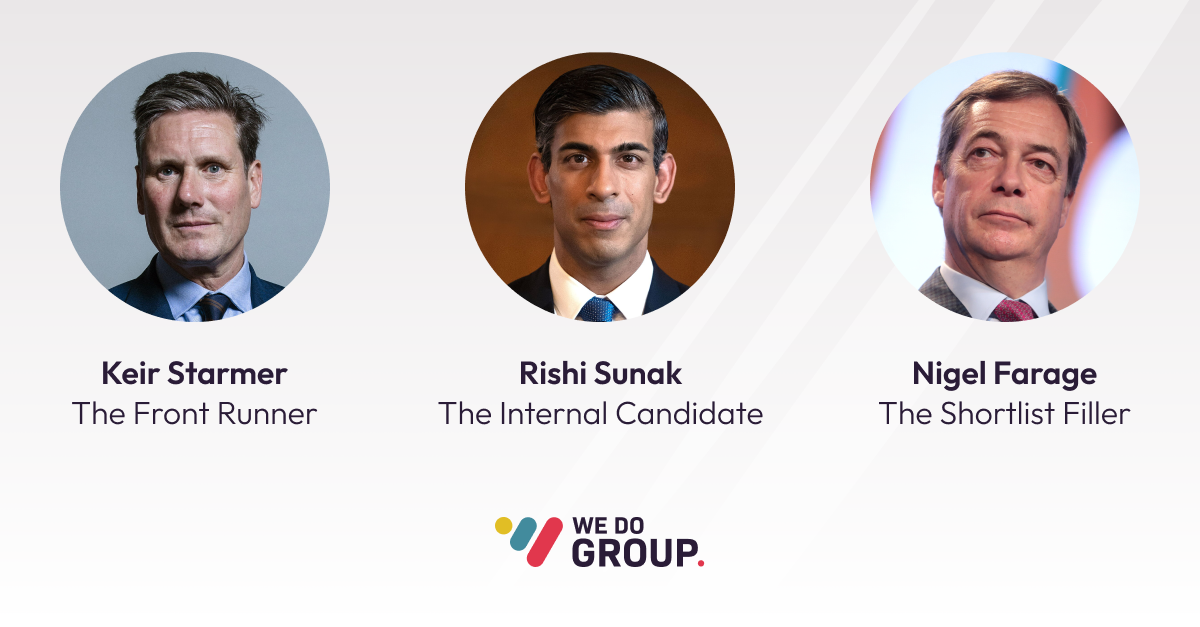A successful recruitment process is always defined by the quality of the shortlist – that’s a fact. Drawing parallels between political races and recruitment strategies offers insightful lessons on navigating complex hiring landscapes. Here’s a closer look at the candidates from a recruiter’s perspective.

1. The Front Runner: Keir Starmer
When Keir Starmer’s CV lands in your inbox, it’s a rush. It’s the kind of CV that makes you quickly call over a colleague to take a look. Starmer is the candidate who ticks more boxes than not, possessing the right levels of experience, sector knowledge, and clear motivation for the role. It’s likely a great next step for him. However, the real question remains: can he articulate his qualifications in the right way? Can he convey that he brings more to the role than someone internally already doing the job? Often labeled a ‘Golden Bullet’, it’s risky to put all your eggs in one basket.
2. The Internal Candidate: Rishi Sunak
Rishi Sunak represents the recruiter’s nightmare. Already embedded within the company, he knows the ins and outs, has built relationships, and understands how things work. While it might seem like he’s tough to beat, the real question is whether he has impressed enough in his current role to keep it or earn that promotion. Where are his skill gaps, and can an external benchmark bring more to the table? The internal candidate is a double-edged sword: if they don’t get the job, they often leave the business. Yet, if they’ve done well, external candidates need to be exceptional to displace them.
3. The Shortlist Filler: Nigel Farage
Then there’s Nigel Farage. Is he really needed on this list? Some argue he isn’t. The recruiter likely knows he won’t get the job, so is it unfair to include him and waste time? On the other hand, you never know, and it’s excellent interview practice for him. Shortlist fillers like Farage can act as useful benchmarks, showcasing how strong the other candidates are by comparison. While their chances might seem slim, they can still serve a purpose in the overall process. And yes, it’s happened… the ‘they will never get the job’ candidate sometimes ends up getting the job!
Making the Right Choice
Just because you have three options doesn’t mean you need to hire one. It’s human nature to want to make a decision when presented with a choice. However, occasionally, the best decision is to say no, go back to square one, and find someone exceptional, if there is any doubt.
If there is a front runner, be positive, be decisive, and hire quickly. Treat the internal applicant as part of the process, try to be independent, and focus on hiring the best person. The quality of the shortlist truly defines the success of any recruitment process.
Update on the Outcome…
In the end, ‘The Front Runner’ secured the job—a result many would argue was to be expected. This decision might suggest that ‘The Internal Candidate’ didn’t quite meet the mark this time around.
Now that the position is filled, the focus shifts to ensuring a smooth transition. It’s crucial for the new hire to quickly adapt and start delivering on the promises made during the recruitment process. We hope for a seamless onboarding with everything in place—from a thorough handover to a workstation ready with all necessary logins.
Additionally, this transition period is an opportune moment for us to engage further. People settling into new roles often need to build or adjust their teams, and that’s where we can provide significant support. Ensuring the right team surrounds them is crucial, as it sets the foundation for theirs, and ultimately the organisation’s success.





